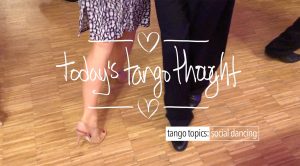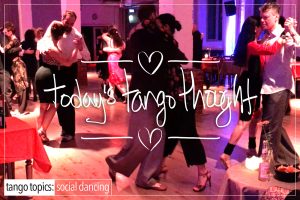The idea of a Practica is ‘theoretically’ to Practice what you have learned. To try out what you have been shown, with multiple partners, as if you were in a class rotation. It is ‘theoretical’ because while the theory is nice, the reality is a little different.
What should be a place for you to practice your extensions, your walk, to work on your stability issues (as a Lead or as a Follower) it is not that at all. What should be an obvious space to encourage an open discussion about technique, music, and codigos for both roles, never happens. What should be place where a Follower can invite a Lead for a song or a series of songs, is viewed as absolute heresy! What should be a safe space to invite suggestions about how you feel as a Lead, or as a Follower is never discussed or broached or even considered. What should be an opportunity for you to explore vocabulary options and opportunities so that you can refine things and how they work with different partners is replaced by dancing with partner after partner after partner as if it were a Milonga and no discussion or actual ‘work’ happens. What should a place where the dj is playing musical genres and not tandas is replaced by tandas and constructing of an entire night of music that is planned out as if it were a Milonga. What should be a place where you should be focusing on your embrace, posture, hands, head, pressure, tension, force, compression is thrown out in favor of just the dancing socially part with no discussion of what’s actually going on. This is space where people invite as many people as possible dance with, and there’s absolutely no feedback that happens. This should be a space where you can go by yourself (say it with me, ‘ALONE’) and focus on you and what you’re doing but instead it’s a Milonga that is called a ‘Practica’.
In the United States, the idea of a ‘Practica’ is really just an excuse for a Milonga. In Germany, Denmark, Finland, the UK, and the rest of europe, the Practica is usually a guided class where you practice a step/pattern/figure with the same partner, over and over again. But there’s no open practica. The very idea is a foreign concept.
In Buenos Aires, there are only 1 real Practica where you can actually stop and engage in a healthy conversation about what you’re doing. The DNI Practica on Saturday afternoons. The rest, no offense intended, of the venues you’ll see things listed as ‘Practicas’ but are really just Milongas that have extended hours with better food and the bar is always open. Always.
The role of the Practica is to give you a place to expand, to try, to fail, to try some more, and to fail some more….to ‘play’ with ideas, concepts, to put them into the real world and see how they can fit into your dancing ideas. The role of the Practica is to forgo the rules of the Milonga which would prevent you from engaging in a conversation about Technique. This is done so that you can work on yourself and create some kind of mirror feedback as a check on reality instead of the echo chamber that so frequently happens for people. The confirmation bias that is makes you believe that what you’re doing is ‘ok’ when in fact it’s more than likely marred by any number of issues. The role of the Practica is to create a space where you can watch, learn, try, fail, explore, fail again, fail some more, succeed a bit, watch some more, rest, relax, and then get up and do it all over again. That is the role of the Practica.
The role of the Practica is to PRACTICE, not Milonga.











